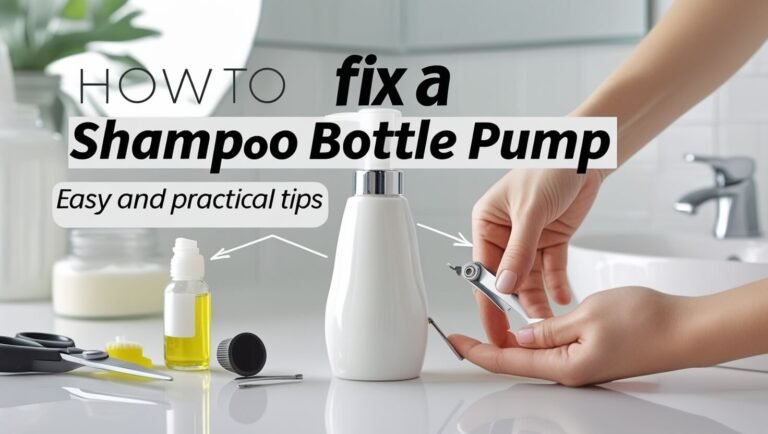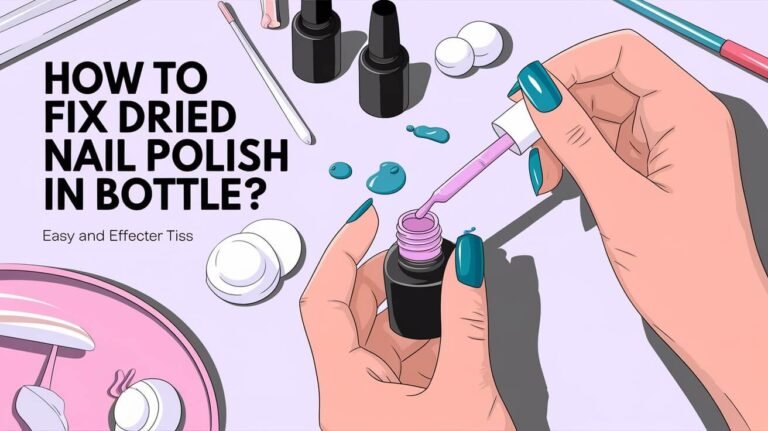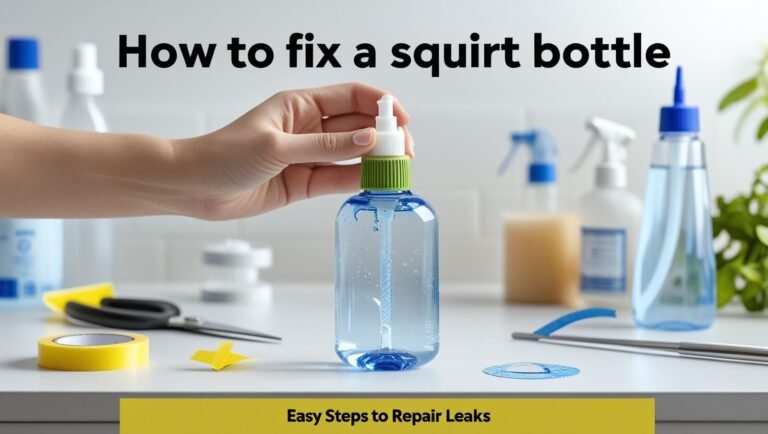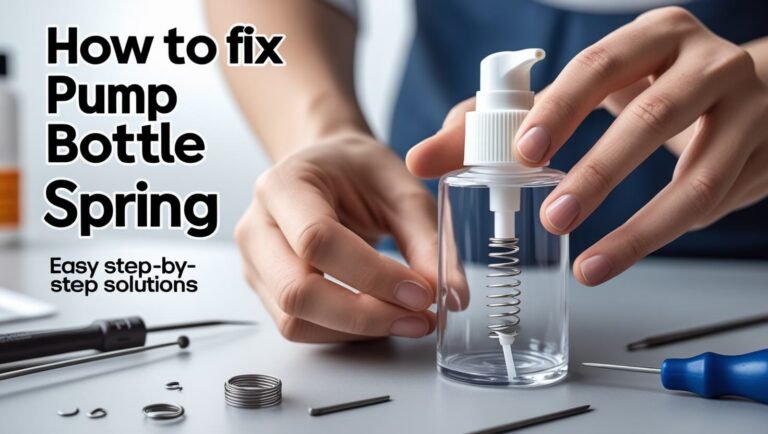How to Fix a Pump Bottle That Won’t Pump?
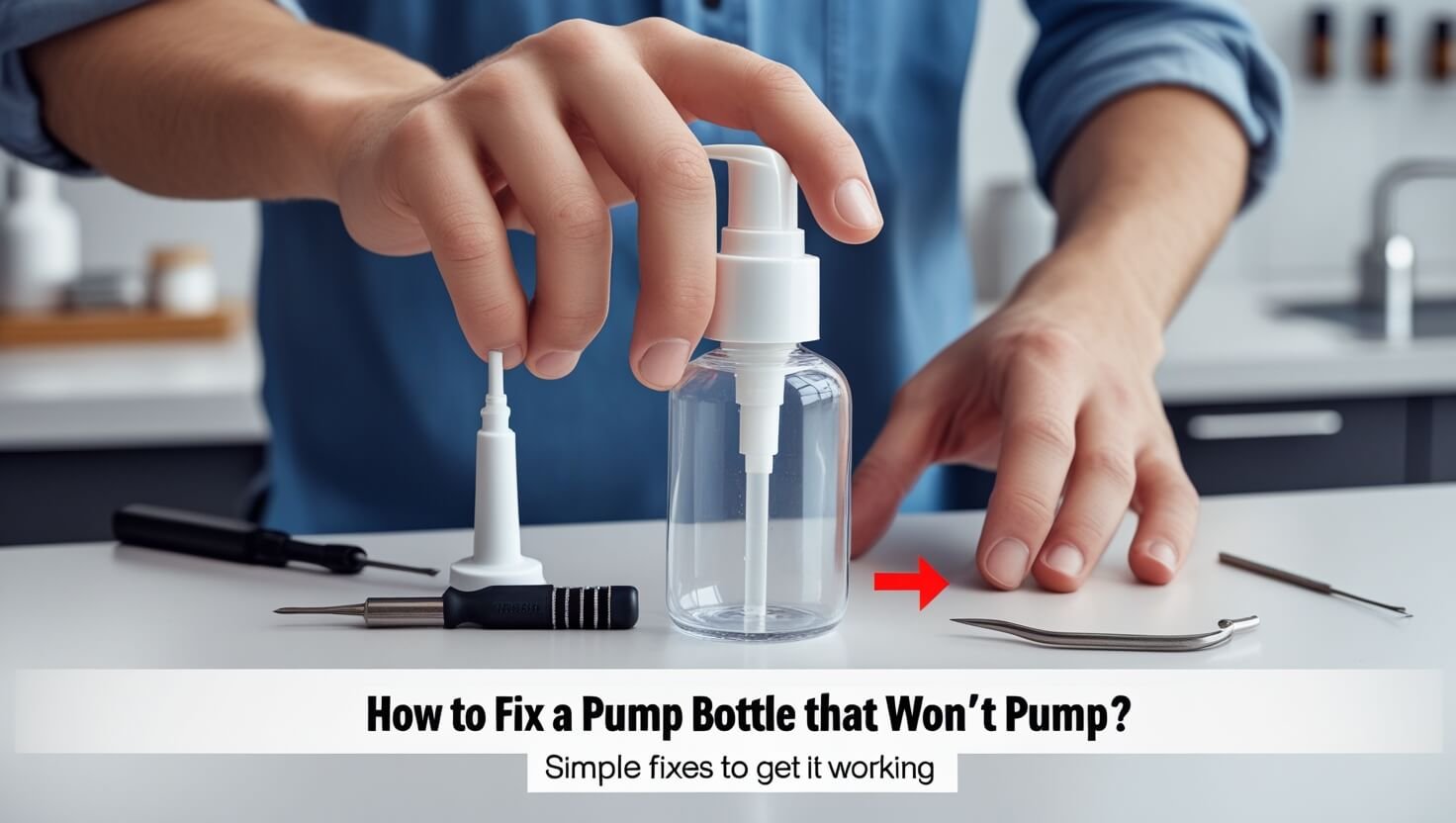
Ever struggled with a pump bottle that won’t work? You’re not alone. Many face the frustration of a broken pump bottle, whether it’s for hand soap or shampoo. Can you fix it yourself, or do you need a new one? We’ll dive into pump bottle repair and show you how to fix it easily.
First, find out why it’s not working. Is it clogged or a mechanical issue? Knowing the common problems helps you troubleshoot. We’ll walk you through fixing a pump bottle that won’t pump. You’ll learn how to get it working again.
Common Pump Bottle Problems
When a pump bottle stops working, it can be really frustrating. A common problem is when the pump gets stuck. This might happen because of air locks or clogs. Keeping your pump bottle well-maintained can help avoid these issues, but sometimes they can’t be avoided.
To find out why the pump isn’t working, check for blockages or air bubbles. If the pump is stuck, try using a wrench to twist the top. This simple action might fix the problem and get your pump bottle working again.
Air Lock Issues
Air lock problems happen when air gets trapped in the pump. This stops it from working right. To fix this, look for air bubbles in the container and prime the pump to clear any blockages.
Clogged Mechanisms
Clogged mechanisms can also stop a pump bottle from working. This might be because of dried-up product or other debris. Regular cleaning can help avoid this, but if it happens, try soaking the pump in hot water to clear blockages.
Broken Springs
Broken springs can also cause problems with a pump bottle. If this is the issue, you might need to replace the spring or the whole pump. But before you do that, try fixing the problem with the methods mentioned above. This might solve the issue without needing to replace anything.
Quick Fixes for Pump Bottle Issues
To fix a pump dispenser, first find out why it’s not working. Check for clogs or air locks in the mechanism. Try flushing it with fresh water or turning the bottle upside down and pumping.
Common problems include overfilling, using the pump under running water, or not sealing the bottle tightly. Not using the pump often can also cause issues. To avoid these, use the right dilution rates and pump regularly.
Here are some quick fixes to try: * Check for clogs or air locks in the pump mechanism * Flush the pump with fresh water * Turn the bottle upside down and pump * Avoid overfilling or using the pump under running water * Use the pump bottle regularly to prevent soap from drying out
If these fixes don’t work, you might need to disassemble or replace the pump. But, this should be a last resort. It can be hard to put the pump back together. By following these tips, you can fix your pump dispenser and get it working again.
| Issue | Solution |
|---|---|
| Pump not dispensing | Check for clogs or air locks, flush with fresh water |
| Pump mechanism failure | Repair or replace the pump mechanism |
| Soap drying out in the mechanism | Use the pump bottle regularly, avoid infrequent use |
Parts of a Pump Bottle Mechanism
To fix a pump bottle, knowing its parts is key. A pump bottle has three main parts: the bottom, the lock, and the pump. Finding out which part is broken is the first step in fixing it.
Keeping your pump bottle in good shape helps avoid problems. Start by checking the pump top and stem if it’s not working right. If that doesn’t solve it, look at the spring system inside.
Issues like air locks and clogged nozzles are common. To fix these, use a fine needle or hot water to clear the blockage. Fixing these problems quickly keeps your perfume fresh longer.
| Part of the Mechanism | Description |
|---|---|
| External Components | Pump top and stem |
| Internal Structure | Spring system and nozzle |
| Spring System | Responsible for dispensing the product |
Knowing your pump bottle’s parts and keeping it maintained helps you fix problems. This ensures your pump bottle works well and efficiently.
Step-by-Step Pump Bottle Repair Methods
To troubleshoot pump bottle issues, start by flushing the pump with warm water. Pump it 20 times to clear out clogs or residue. Then, turn the pump upside down and pump 5 times to drain excess water.
Using a wrench to twist the top of the pump is a good move, some say. It helps loosen blockages or debris. Also, flushing with distilled white vinegar and pumping 20 times can kill germs and break down buildup.
Here’s a quick guide to fix a pump bottle that won’t pump:
- Flush the pump with warm water and pump 20 times
- Turn the pump upside down and pump 5 times
- Flush the pump with distilled white vinegar and pump 20 times
- Drain the vinegar solution by turning the pump upside down and pumping 5 times
- Rinse the pump with water to remove any vinegar or residue
These steps can fix your pump bottle. Always clean and maintain your pump bottle to avoid future problems.
| Step | Action | Result |
|---|---|---|
| 1 | Flush with warm water | Clear clogs and residue |
| 2 | Drain excess water | Remove excess water from mechanism |
| 3 | Flush with vinegar | Kill germs and break down buildup |
Tools Required for Pump Bottle Fixes
To fix a pump bottle that’s not working, having the right tools is key. Regular maintenance can prevent problems like a stuck pump. A needle-nose plier is needed to grip the pump top, as repair guides suggest.
Many household items can serve as tools. These include:
- A flathead screwdriver for disassembling the pump mechanism
- A pair of tweezers for removing small debris or blockages
- A cloth or soft brush for cleaning the pump and bottle
For more complex repairs or specific pump bottles, specialized tools might be needed. This includes a pump repair kit with parts like O-rings or springs. A bottle brush is also useful for cleaning hard spots. Knowing the threading dimensions for household bottles helps in choosing the right tools and parts.
| Tool | Description |
|---|---|
| Needle-nose plier | For gripping small parts |
| Flathead screwdriver | For disassembling the pump |
| Pump repair kit | For replacing worn-out parts |
With these tools and knowledge, you can maintain your pump bottle. This helps fix issues like a non-working pump or a stuck pump. Your pump bottle will last longer and work better.
Professional Solutions for Stubborn Pump Problems
When a pump bottle won’t dispense, getting professional help is key. Sometimes, a quick fix can solve the problem. But other times, you might need expert care. Knowing what’s causing the issue is the first step to fixing it.
A common problem is a clogged nozzle. You can soak it in saponaceous water or acetic acid for 10 minutes. Or, try hot water for a few minutes. For tough clogs, a fine needle or pin can help. Cleaning the nozzle after each use can also prevent clogs.
To avoid air pockets in perfume bottles, keep them cool and dark. Avoid shaking the bottle too much. If the pump breaks, you might need to fix or replace it. Sometimes, moving the perfume to a new bottle or making it solid is the best option.
Here are some steps to tackle stubborn pump problems:
- Check the pump bottle for blockages or clogs
- Clean the nozzle and pump regularly
- Store perfume in a cool, dark place
- Avoid shaking the bottle too much
Following these steps and seeking professional help can keep your pump bottle functioning properly.
This will prevent issues like a pump bottle not dispensing.
Cleaning and Maintenance Tips
Keeping your pump bottle clean is key to avoiding problems and making it last longer. Regular cleaning can spot issues early. This means you can fix them quickly, avoiding bigger pump bottle repair or troubleshoot pump bottle tasks.
Every day, check for air bubbles in your bottle. Also, clean the nozzle and pump often to stop clogs.
Daily Care
- Check for air bubbles in the product container
- Clean the nozzle and pump regularly
- Inspect the pump bottle for any signs of damage or wear
Deep Cleaning Methods
For a deeper clean, soak the parts in warm soapy water. Or, try a baking soda and water mix for tough blockages. Deep cleaning keeps your pump bottle working well. It also helps avoid the need for pump bottle repair or troubleshoot pump bottle fixes.
Prevention Strategies for Future Issues
To keep your pump bottle working well, regular maintenance is key. Check for blockages or debris that might be causing problems. These steps will help your pump bottle work smoothly and efficiently.
Preventing issues starts with using a needle-nose plier to twist the pump top. This can fix air locks. Also, cleaning and drying the pump bottle often stops bacteria and clogs.
Here are some tips to avoid future problems with your pump bottle:
- Regularly check the pump bottle for any signs of wear or damage
- Perform routine cleaning and maintenance to prevent clogs and blockages
- Use a needle-nose plier to release any air locks that may be causing the pump bottle not to work
- Store the pump bottle in a cool, dry place to prevent the growth of bacteria and other microorganisms
By using these prevention strategies, your pump bottle will work better. Always check for problems and fix them quickly. This way, you’ll avoid big issues and reduce maintenance needs.
| Prevention Strategy | Benefits |
|---|---|
| Regular cleaning and maintenance | Prevents clogs and blockages, reduces need for pump bottle maintenance |
| Using a needle-nose plier to release air locks | Helps to prevent pump bottle not working, reduces need for repair |
| Storing the pump bottle in a cool, dry place | Prevents growth of bacteria and other microorganisms, reduces need for cleaning |
Signs Your Pump Bottle Needs Replacement
Knowing when to fix or replace a pump bottle is key. Over time, pump bottles can get damaged or stop working right. Keeping them in good shape helps, but sometimes, you need a new one.
Look out for cracks, corrosion, or a lot of wear. If you see these signs, it might be time for a new pump bottle. Also, if fixing problems doesn’t work, getting a new one might be best.
Physical Damage Indicators
Physical damage is a clear sign you need a new pump bottle. Check for cracks, breaks, or corrosion on the pump or bottle. If you find any, it’s time for a replacement.
Performance Issues
Performance problems can also mean it’s time for a new pump bottle. If it’s not dispensing well or leaking, it’s likely time for a change. Cleaning and checking for blockages can help, but sometimes, you need a new one.
Conclusion
By following the steps in this article, you can fix a pump bottle that won’t pump. We’ve covered common problems like air locks and clogged parts. We also talked about deep cleaning and maintenance to keep your pump bottles working well.
Preventing problems is important for your pump bottles to last longer. Clean the parts regularly, dispense air correctly, and pick quality airless pump bottles. These steps help avoid future issues and keep your toiletries and cosmetics ready, even when you’re traveling.
Understanding how a pump bottle works and using the right repair methods can save you from early replacements. A little effort can make pump bottles convenient and efficient for many years.
Common Questions:
What are the common problems that can cause a pump bottle to stop working?
Common issues include air locks, clogged parts, and broken springs.
How can I fix a pump dispenser that is not working?
Start by troubleshooting and trying quick fixes. This might mean unclogging or repairing the mechanism.
What are the different parts of a pump bottle mechanism?
A pump bottle has external parts, an internal structure, and a spring system. These work together to dispense the product.
What tools do I need to fix a pump bottle?
You’ll need household items and tools like a wrench. These can help fix a pump bottle that won’t work.
How do I maintain my pump bottle to prevent future issues?
Follow daily care and deep cleaning methods. Also, use prevention strategies to avoid common problems.
How do I know when my pump bottle needs to be replaced?
Replace it if you see physical damage or performance issues. These signs mean the mechanism can’t be fixed.

